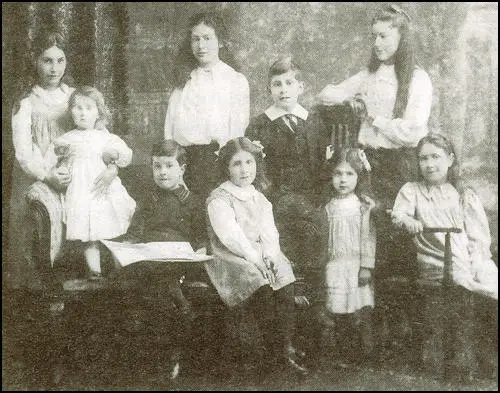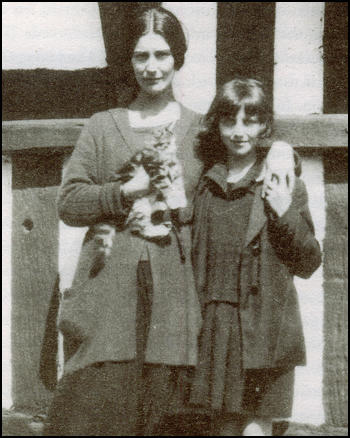Walter Garman
Walter Garman was born in 1861. He studied medicine at Heidelberg and Edinburgh and in 1888 he became medical officer for Wednesbury, for the annual salary of £84. According to Cressida Connolly, the author of The Rare and the Beautiful: The Lives of the Garmans (2004): "Walter was tall and dark, with expressive eyes and arched brows. He wore a dropping moustache and had a slightly melancholy look, like a Spanish don."
In 1897 Garman married Margaret Magill, who was nearly twenty years younger than her husband. Her mother-in-law wrote to her claiming that: "I can promise you that you will have one of the most honourable, good-tempered, affectionate, high-principled men that it is possible to meet with and I cannot see any reason that such a union can fail to be a happy one." The couple rented Oakeswell Hall, a Jacobean house, and over the next few years had nine children: Mary (1898), Sylvia (1899), Kathleen (1901), Douglas (1903), Rosalind (1904), Helen (1906), Mavin (1907), Ruth (1909) and Lorna (1911).
Cressida Connolly argues that: "Garman was personally responsible for the introduction of flushing water closets to the area, an innovation which must have saved many thousands of people from typhoid and cholera. Walter was immensely popular, would help the poor without charge, and, although he claimed never to use anything but aspirin and vinegar, was known as an extremely fine doctor."

Mavin, Mary, Rosalind, Douglas, Ruth, Sylvia and Helen.
Later Kathleen Garman wrote about life in Oakeswell Hall: "It was... overrun with children and horses and pony and dogs and cats and rabbits and guinea pigs and cocks and hens - an old courtyard, surrounded by the house itself and all around the stables, the schoolroom, the laundry, an old malt house we called the bogey hole where we had three unsafe storeys of dirty and dusty old buildings for hiding and playing."
Walter Garman was seen as a highly respectable member of the community but one of his daughters, Helen, later told a friend that her father "was a cruel, bad-tempered, ferocious man who beat his children and locked them in cupboards." However, another one of his children, Mavin, only remembers receiving one beating from his father.
Garman, like his wife, held deeply religious views and the local church played an important role in the child's upbringing. He was also a magistrate and an active member of the Conservative Party. Two of his daughters, Kathleen and Mary, went to art classes in Birmingham. They also bought books and when Walter Garman caught them reading Madame Bovary, he summoned all the children and burned it on the fire in front of them.
In 1919 the two sisters rebelled and ran away to London. Kathleen took a job helping with the horses that pulled carriages for Harrods and also worked as an artist model, whereas Mary drove a delivery van for Lyons' Corner Houses. Dr. Garman was deeply shocked by this behaviour and eventually decided to give both his daughters an allowance, which enabled them to give up their jobs and enroll at a private art school called the Heatherley.

In December 1921, Kathleen and Mary took the poet, Roy Campbell to Oakeswell Hall. Kathleen introduced him with the words: "Father, this is Roy, who's going to marry Mary." Garman was furious as he did not approve of his future son-in-law. Not only was he unemployed, it was also clear that he had a serious drink problem. Garman also strongly disapproved of Kathleen's relationship with Jacob Epstein.
Mary and Campbell were married in 1922. The bride wore a long black dress with a golden veil whereas he put on his old suit. One guest observed that when he knelt at the altar he had holes in the soles of his shoes, padded with newspaper. Percy Wyndham Lewis was one of the guests at the wedding: "The marriage feast was a distinguished gathering, if you are prepared to admit distinction to the Bohemian, for it was almost gipsy in its freedom from the conventional restraints."
Walter Garman died at Oakeswell Hall in May 1923 after suffering a heart-attack. The family believed that he had been killed by overwork, for he was only sixty-two.
Primary Sources
(1) Mary Dearborn, Peggy Guggenheim: Mistress of Modernism (2004)
Born in 1903 to a wealthy doctor and his wife (she was said to be half-Gypsy), he (Douglas Garman) grew up in an Elizabethan manor house called Oakeswell Hall in Wednesbury, near Birmingham in Staffordshire. Garman had a brother, Mavin, a farmer in Hampshire, and seven remarkable sisters, several of whom would figure in Peggy's life in the future. The beautiful Garman girls carried on a dizzying, decades-spanning roundelay of marriages and affairs with prominent men that would have left Alma Mahler envious. They included Mary, who married the fascist South African poet Roy Campbell and had an affair with Vita Sackville-West; Sylvia, who was said to have had an affair with the elusive T. E. Lawrence; Kathleen, the muse and mistress of Sir Jacob Epstein, the sculptor, who became his wife only after bearing him three children; Rosalind, who prosaically married a garage owner and had two children; Helen, who married a half-Norwegian fisherman in France and had a daughter, Kathy, who married the much-loved poet and memoirist Laurie Lee (whose Cider with Rosie was published in 1959); Ruth, who lived in Herefordshire and had several children by different men; and Lorna, perhaps the most beautiful of all, who married Ernest Wishart, the publisher who employed Douglas Garman, and bore him a child at seventeen, later had an illegitimate daughter with Laurie Lee (afterward her niece Kathy's husband), and later still had an affair with the painter Lucian Freud (who, in turn, later married and had a child with Kitty Epstein, another of Lorna's nieces, the daughter of Kathleen). Peggy was to consider all these Garmans as a kind of honorary family.
(2) Peggy Guggenheim, Out of the Century (1979)
Garman was the son of a family doctor who had had a large practice outside Birmingham. There he had lived in a big house with a garden, completely removed from the world, with his one brother and seven sisters. His father died while Garman was still at Cambridge, and Garman felt his loss very much and his early responsibilities of being head of the family. His mother was a gentle English lady living in retirement and great modesty. She was supposed to be the illegitimate daughter of Earl Grey, and indeed she looked aristocratic. She was so feminine and so ladylike she had always done exactly what her husband had wanted, and now, although she rarely saw Garman, she adored him and treated him in the same way. He had just bought a little house for her in Sussex near the downs and he intended to go down there for weekends...
Garman drove me to Sussex to show me the house he had bought for his mother. It was in a little English village called South Harting, just under the downs. The village was absolutely dead, like all such places in England, but it was in the midst of the most lovely country. Naturally, it had a fine pub. Garman also took me to see his sister Lorna and his brother-in-law, the publisher Ernest Wishart, whom he called Wish. They had a lovely home. Garman and Wish seemed to be the very best of friends, having been to Cambridge together. Wish's wife Lorna was the most beautiful creature I had ever seen. She had enormous blue eyes, long lashes and auburn hair. She was very young, still in her early twenties, having been married at the age of sixteen. Out of seven sisters, she was Garman's favorite. They were all extraordinary girls. One of them was married to a fisherman in Martigues, and another one had three children by a world-famous sculptor. Another lived in Herefordshire with her illegitimate child, while a fourth spent half the year as a maidservant in order to be able to live in peace the other six months in a cottage she had bought on Thomas Hardy's favorite heath. Later she adopted a little boy and was reported to have had a love affair with Lawrence of Arabia, whom she met on the heath, but when I knew her she was most virginal. Another one was married to the famous South African poet Roy Campbell. They were Catholic and later became Fascist and lived in Spain. One very normal one married a garage owner and led a happy life with two children. In his youth Garman must have been overwhelmed by so many women, and preferred not to see most of them any more. However, I was fascinated by them and eventually managed to meet them all. Garman had a younger brother whom he liked. He had returned from Brazil and was now farming in Hampshire.
